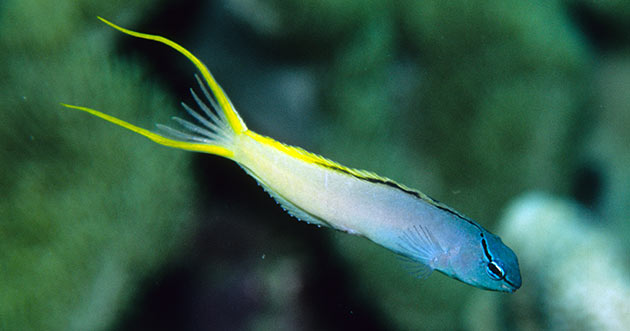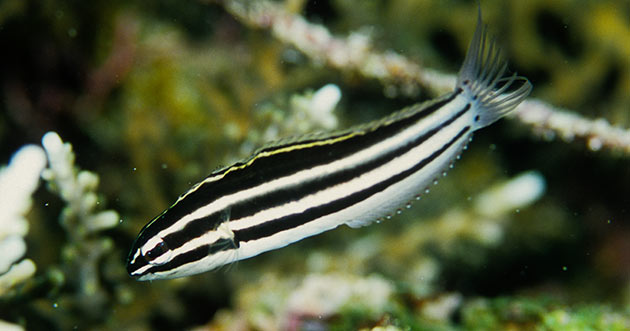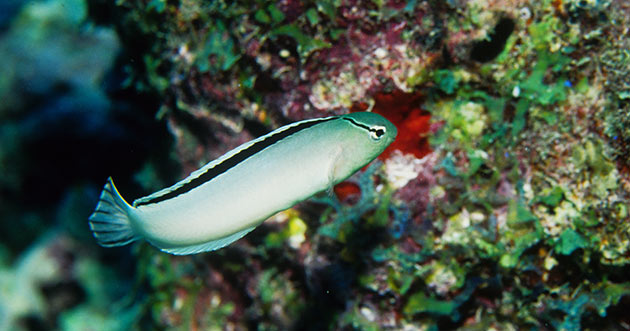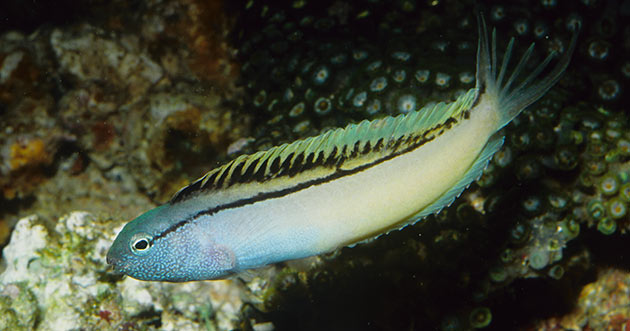
The genus Meiacanthus is comprised of 28 species of small, unique Blennies. They belong to the Blenny tribe Nemophini, which includes other odd species in the genera Aspidontus, Petroscirtes, and Xiphasia. All the Meiacanthus Blennies are found in the Indo-Pacific, with most residing in coral reef habitats. There is at least one species that has been reported from freshwater environs.
While the majority of Blenny species spend the bulk of their time in repose on the substrate and exhibit coloration that help them blend in with their surroundings (with the exception of the brightly attired genus Ecsenius), Lyretail Fang Blennies are very different. Most sport bright colors or bold patterns and all of these fishes spend much of their time swimming over the substrate. The pattern of mobility they typically display is: hover in the water column, dash forward (swimming in an eel-like fashion for a short distance), stop abruptly and resume hovering. When moving slowly or maintaining their position in the water column, they use their pectoral fins. When they want to locomote in haste, they use their tail. They have a well-developed swim bladder (an organ that is lacking in benthic Blennies) which facilitates their ability to remain suspended in the water column.
Lyretail Fang Blennies feed on a variety of small invertebrates. For example, they will ingest annelid worms, ostracods (tiny crustaceans), and foraminiferans (shelled protozoa). It will ingest these prey items from sand and hard substrates. They will also pick zooplankton from the water column as well. These Blennies do ingest some algae, but do so much less frequently than most others in the family.

Meiacanthus atrodorsalis |
Adult Meiacanthus are observed singly or in pairs, although they are occasionally found in temporary groups. Their social behavior has not been studied in the wild, but there is some indication that they may be territorial (captive observations suggest that some species are haremic, with a male defending a group of females). Juveniles occasionally form small aggregations. When most Lyretail Fang Blennies seek shelter, they back into small holes in the reef (e.g., empty tubeworm holes), tail-first.
Why They are Called Fang Blennies
The distinguishing characteristic of Lyretail Fang Blennies (as well the others in their tribe) is their very unique dentition. Meiacanthus spp. have large fang-like canines in the lower jaw. These fangs have a groove on the front edge that travels to the base of the tooth filled with glandular tissue. These teeth are not used to capture prey; no, they’re used for defense. When Lyretail Fang Blennies are ingested by another fish, they will bite back! This usually means sinking their fangs into the mouth or pharynx of the would-be predator. The cells that comprise the glandular tissue at the base of each fang exudes a toxin. When the Blenny bites, toxin is forced along the groove and into the wound, which typically cause the predator to immediately spit the little fish out of its mouth! This is usually accompanied by the predatory fish quivering, distending the gill covers and the jaws (i.e., obvious discomfort). The rejected Lyretail Fang Blenny is usually no worse for wear after its dramatic encounter. Biologists that have been bitten by a Meiacanthus report that it feels like a mild bee sting.

Meiacanthus crinitus |
Some predators will eat Meiacanthus, but these are typically piscivores that do not ingest their prey whole. For example, captive Rockmover Wrasse (Novaculichthys taeniourus) will readily eat these Blennies. These Wrasses bite and incapacitate the Blenny before they attempt to swallow it, thus “disarming” the little fish before it can strike. Suction-feeding fishes, like Frogfishes, Lionfishes, and Groupers are more likely to suck-up and then spit-out Lyretail Fang Blennies. However, even these types of fishes successfully ingest a biting Blenny on occasion.
Functional Coloration of Lyretail Fang Blennies
As mentioned above, Meiacanthus Blennies are often more brightly attired than most other Blennies. Their coloration may serve an aposematic or warning function – that is, they advertise their noxious nature by exhibiting these bright colors. Predators learn quickly to steer clear of these biting Blennies. In captivity, Groupers fed and then bitten by a Meiacanthus Blenny, will not attempt to eat these fish again - one bad experience is enough to dissuade them.

Meiacanthus smithi |
There are several reef fishes that mimic Lyretail Fang Blennies. In fact, Meiacanthus spp. are involved in four of the five types of mimicry described in reef fish communities. The most common type is known as Batesian Mimicry – this is where a non-noxious species looks like a noxious one. A non-noxious species resembling Meiacanthus spp., is very likely to be avoided by predators that have had bad experiences with noxious Blennies. Batesian mimics of Lyretail Fang Blennies include other Blennies, Cardinalfishes, and Spinecheeks. For example, the Red Sea Mimic Blenny (Ecsenius gravieri) closely resembles the color of the Blackline Fang Blenny (Meiacanthus nigrolineatus). The former species has no dentary defenses, but any piscivore that has encountered M. nigrolineatus is likely to avoid E. gravieri because they look so much alike. Another interesting mimetic complex involves the Onestripe Fang Blenny (Meiacanthus vittatus), the Pearly Spinecheek (Scolopsis margaritifer), and the Mimic Cardinalfish (Cheilodipterus parazonatus). The Spinecheek and Mimic Cardinalfish look alike and behave similarly to M. vittatus (that is, they hover and swim above the sea floor).

Meiacanthus nigrolineatus |
The Meiacanthus spp. are also involved in Müllerian Mimicry. This is where one or more noxious species resemble each other. If a piscivore has a bad experience with one of these species, it will learn to avoid any fish sporting the same chromatic livery. The Striped Fang Blenny (Meiacanthus grammistes), Lined Fang Blenny (M. lineatus), Shorthead Fang Blenny (Petroscirtes breviceps) and Yellow Fang Blenny (Petroscirtes fallax) all look alike and all four have venomous fangs (they all belong to the tribe Nemophini).
Members of the genus Plagiotremus, which are known as Imposter Blennies, employ Aggressive Mimicry. An aggressive mimic resembles another species to gain access to prey. Plagiotremus Blennies feed by biting scales and slime off of passing fishes. By looking like more common and non-threatening Lyretail Fang Blennies, they can more closely approach a naive piscine victim before launching an attack. An example of this type of mimetic relationship is demonstrated between the Bicolor Imposter Blenny (Plagiotremus laudandus) and the Yellowtail Fang Blenny (Meiacanthus atrodorsalis).
Part 1:
Classification and Biology of Lyretail Fang Blennies |
| |
Part 2:
Captive Care of Lyretail Fang Blennies |

Scott Michael
Scott W. Michael is an internationally-recognized writer, underwater photographer, and marine biology researcher specializing in reef fishes, and was the Banquet Speaker at our 2007 and 2008 Coral Conference and Frag Swap. He is a regular contributor to Aquarium Fish Magazine, Freshwater and Marine Aquarium Magazine, SeaScope, and is the author of Reef Fishes Vol 1, Vol 2, and Vol 3, Vol 4, and Vol 5., A Pocket Expert Guide Marine Fishes, A Pocket Expert Guide to Reef Aquarium Fishes, 101 Best Saltwater Fishes: How to Choose and Keep Hardy, Brilliant, Fascinating Species That Will Thrive in Your Home Aquarium, Reef Sharks & Rays of the World, and Aquarium Sharks & Rays. Having studied marine biology at the University of Nebraska, Scott has served as a scientific consultant for National Geographic Explorer, the Discovery Channel, and French educational television.
References:
Fishelson, L. 1975. Observations on behavior of the fish Meiacanthus nigrolineatus Smith-Vaniz (Blenniidae) in Nature (Red Sea) and in Captivity. Aust. J. Mar. Freshwater Res. 26(3): 329-341.
Losey, G.S. Jr. 1975. Meiacanthus atrodorsalis: field evidence of predation protection. Copeia. 1975(3): 574-576.
Moorhead, J.A. and Zeng, C., 2011. Breeding of the forktail blenny Meiacanthus atrodorsalis: broodstock management and larval rearing. Aquaculture, 318(1), pp.248-252.
Russell, B.C., Allen, G.R., and H.R. Lubbock. 1976. New cases of mimicry in marine fishes. J. Zool. Lond. 180(3): 407-423.
|